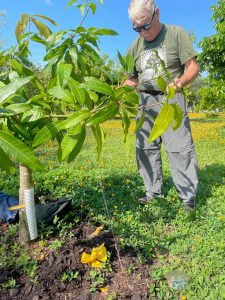Mangos are potentially very large trees that can get out of hand if left unmanaged for height and shape. In hurricane prone areas, it is recommended to regularly prune mango trees to limit vertical growth and encourage horizontal growth.
Controlling the height and spread of the mango tree from an early age will be beneficial when it’s time for maintenance pruning, spraying for disease, harvesting fruit and reduces the chance of being blown over in strong winds and flooding.
In the video below, Mr. Crafton Clift and Mr. Rodger Taylor of the Collier Fruit Growers describe the two shapes of a mango tree; the “juvenile V” where growth shoots-up vertically and the “lazy W” where the tree is manipulated to produce new growth horizontally.
This ‘Lalijiwa’ (Mangifera Lalijiwa, a mango relative) in the Collier County Extension tropical fruit grove was continuing to grow in the undesirable, vertical “v” shape instead of the low, bushy structure of the “lazy W” shape. Without proper pruning and shaping, this tree would get too big to manage.
One way to achieve the low, bush form is by staking branches to be horizontal with the ground. Staking mango trees or other tropical fruit tree branches is a great way to train the tree to grow out instead of up. The branches are gently bent outwards and pulled down with loose ties to give movement in the wind.

Staking mango branches forces the tree to create stronger branch unions to hold more fruit. Also, environmental factors such as proper pruning practices, water irrigation to mitigate drought, seasonal light, and nutrient management can affect the hormone release of the trees which determine new leaf growth, fruit production, and leaf abscission (or leave fall). Since hormone release determines whether the tree will grow leaves or flowers, manipulating the tree to stay small and horizontal could benefit fruit production.
Join Mr. Crafton and Mr. Rodger for the Collier Fruit Growers Club meeting at the UF/IFAS Extension Collier campus. They group meets once a week on Thursday mornings. New members are welcome: Collier Fruit Growers
For the information on pruning mangos : https://sfyl.ifas.ufl.edu/media/sfylifasufledu/miami-dade/documents/tropical-fruit/CommonMangoQuestionsRevised.pdf
 4
4
